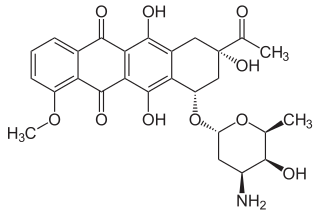Anthracycline
|
WikiDoc Resources for Anthracycline |
|
Articles |
|---|
|
Most recent articles on Anthracycline Most cited articles on Anthracycline |
|
Media |
|
Powerpoint slides on Anthracycline |
|
Evidence Based Medicine |
|
Clinical Trials |
|
Ongoing Trials on Anthracycline at Clinical Trials.gov Trial results on Anthracycline Clinical Trials on Anthracycline at Google
|
|
Guidelines / Policies / Govt |
|
US National Guidelines Clearinghouse on Anthracycline NICE Guidance on Anthracycline
|
|
Books |
|
News |
|
Commentary |
|
Definitions |
|
Patient Resources / Community |
|
Patient resources on Anthracycline Discussion groups on Anthracycline Patient Handouts on Anthracycline Directions to Hospitals Treating Anthracycline Risk calculators and risk factors for Anthracycline
|
|
Healthcare Provider Resources |
|
Causes & Risk Factors for Anthracycline |
|
Continuing Medical Education (CME) |
|
International |
|
|
|
Business |
|
Experimental / Informatics |
Editor-In-Chief: C. Michael Gibson, M.S., M.D. [1]
Overview




Anthracyclines are a class of chemotherapeutic agents based upon samine and tetra-hydro-naphthacene-dione. These compounds are used to treat a wide range of cancers, including (but not limited to) leukemias, lymphomas, and breast, uterine, ovarian, and lung cancers.
Examples
Available agents include:
- Daunorubicin
- Daunorubicin (liposomal)
- Doxorubicin
- Doxorubicin (liposomal)
- Epirubicin
- Idarubicin
- Mitoxantrone
Anthracyclines technically are also antibiotics, although their high toxicity precludes their use as such.
Mechanism of action
Anthracyclines inhibit DNA and RNA synthesis by intercalating between base pairs of the DNA/RNA strand, thus preventing the replication of rapidly-growing cancer cells.
They also create iron-mediated free oxygen radicals that damage the DNA and cell membranes.
Anthracyclines are also capable if inhibiting topoisomerase II enzymes, preventing DNA from relieving torsional stress during replication.
Cardiotoxicity
As well as many of the expected adverse reactions of chemotherapeutic agents, anthracyclines are notorious for causing cardiotoxicity. This cardiotoxicity may be caused by many factors, which may include interference with the ryanodine receptors of the sarcoplasmic reticulum in the heart muscle cells, free radical formation in the heart or from buildup of metabolic products of the anthracycline in the heart. The cardioxicity often presents as EKG changes and arrhythmias, or as a cardiomyopathy leading to congestive heart failure (sometimes presenting many years after treatment). This cardiotoxicity is related to a patient's cumulative lifetime dose. A patient's lifetime dose is calculated during treatment, and anthracycline treatment is usually stopped (or at least re-evaluated by the oncologist) upon reaching the maximum cumulative dose of the particular anthracycline.
There exists evidence that the affect of cardiotoxicity increases in long term survivors, from 2% after 2 years to 5% after 15 years. [1]
Dexrazoxane is a cardioprotectant agent that is sometimes used to reduce the risk of cardiotoxicity. Liposomal formulations of daunorubicin and doxorubicin have been approved that appear to be somewhat less toxic to cardiac tissue.
References
Additional Resources
- Lacy, Charles F; Armstrong, Lora L; Goldman, Morton P; Lance, Leonard L (2004) Lexi-Comp's Drug Information Handbook (12th Edition) Lexi-Comp ISBN 1-59195-083-X
- Fischer, David S; Knobf, M Tish; Durivage, Henry J; Beaulieu, Nancy J (2003) The Cancer Chemotherapy Handbook (6th Edition) Mosby ISBN 0-323-01890-4